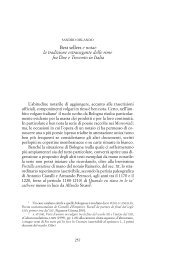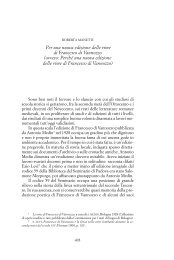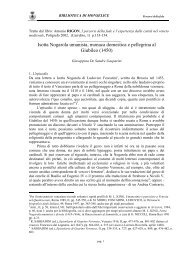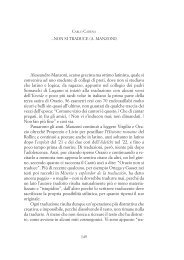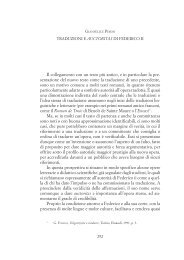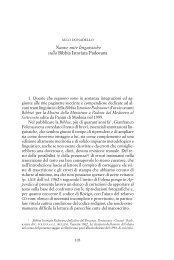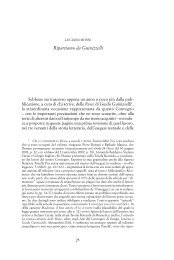(intero volume in formato PDF ( 4 MB circa) - Provincia di Padova
(intero volume in formato PDF ( 4 MB circa) - Provincia di Padova
(intero volume in formato PDF ( 4 MB circa) - Provincia di Padova
Create successful ePaper yourself
Turn your PDF publications into a flip-book with our unique Google optimized e-Paper software.
degradata – assimilazione, come <strong>di</strong>mostra la sua fortuna presso i<br />
novellieri c<strong>in</strong>quecenteschi meno colti e maggiormente periferici e il<br />
riuso delle sue novelle anche dopo la pubblicazione della nuova versione<br />
r<strong>in</strong>ascimentale <strong>di</strong> Le Maçon 18 .<br />
Per <strong>di</strong> più, da un’e<strong>di</strong>zione all’altra, lo stravolgimento non risparmia<br />
nemmeno il titolo. Nelle e<strong>di</strong>zioni Vérard il titolo è Bocace des cent<br />
nouvelles, o, come risulta dal Prologue, Le livre des cent nouvelles.<br />
Come già accadeva talvolta nella precedente tra<strong>di</strong>zione manoscritta,<br />
la denom<strong>in</strong>azione non co<strong>in</strong>cide con quella presente nel colophon che<br />
ripropone l’explicit <strong>di</strong> alcuni manoscritti: Cy f<strong>in</strong>e le livre de cameron<br />
autrement surnommé le pr<strong>in</strong>ce galiot qui contient cent nouvelles 19 . Nelle<br />
e<strong>di</strong>zioni successive è proprio il testo del colophon <strong>di</strong> Vérard ad<br />
essere ripreso come titolo, che <strong>di</strong>venta nell’e<strong>di</strong>zione della Veuve Michel<br />
Lenoir del 1521 Le livre Cameron autrement surnommé le pr<strong>in</strong>ce Galliot<br />
qui contient cent Nouvelles e nella coe<strong>di</strong>zione <strong>di</strong> Ala<strong>in</strong> Lotrian e Denis<br />
Janot del 1537 Le Cameron aultrement <strong>di</strong>t les Cent nouvelles 20 . Inol-<br />
18 Si veda: SALWA, Le tre fortune del Decameron nella Francia del C<strong>in</strong>quecento, cit.<br />
Oltre che nelle Cent Nouvelles nouvelles <strong>di</strong> Philippe de Vigneulles, composte a Metz verso il<br />
1514-1515, nel Parangon des nouvelles honneste et délectables (Lyon, Roma<strong>in</strong> Mor<strong>in</strong>, 1531)<br />
e nel Grand Parangon des Nouvelles nouvelles <strong>di</strong> Nicolas de Troyes, term<strong>in</strong>ato a Tours nel<br />
1536 e che riprende ben c<strong>in</strong>quantasette novelle al Livre de cent nouvelles, è nelle Joyeuses<br />
narrations advenues de nostre temps, raccolte e stampate a Lione da Benoist Rigaud e Jean<br />
Saugra<strong>in</strong> nel 1557, rie<strong>di</strong>te nel 1572 e nel 1596, che ritroviamo ancora nove novelle provenienti,<br />
<strong>di</strong>rettamente o <strong>in</strong><strong>di</strong>rettamente tramite il Parangon del 1531, dalla versione <strong>di</strong> Vérard,<br />
accanto ad altre otto riprese alla versione <strong>di</strong> Le Maçon (sulla presenza delle novelle del<br />
Boccaccio nelle raccolte c<strong>in</strong>quecentesche, si vedano: SOZZI, Boccaccio <strong>in</strong> Francia nel C<strong>in</strong>quecento,<br />
cit., pp. 277-279; G.-A. PÉROUSE, Nouvelles françaises du XVI e siècle. Images de la vie<br />
du temps, Genève, Droz, 1977, pp. 75-76, 114-115).<br />
19 La formulazione Cy f<strong>in</strong>e le livre de cameron è presente nei manoscritti Paris BN<br />
fr. 239 e 240 e, secondo Di Stefano, anche <strong>in</strong> Oxford Bodl. Douce 213 (BOZZOLO, Manuscrits<br />
des traductions françaises des œuvres de Boccace XV e siècle, cit., pp. 105, 161; BOCCACE,<br />
Decameron cit., p. 1235). Fra questi, il manoscritto Paris BN fr. 240 presenta <strong>in</strong>oltre la particolarità<br />
<strong>di</strong> essere l’unico dell’<strong>in</strong>tera tra<strong>di</strong>zione a sostituire la novella <strong>di</strong> Iancofiore (VIII, 10)<br />
con la novella apocrifa <strong>di</strong> Angele du Banc che ritroviamo poi nelle e<strong>di</strong>zioni a stampa (si<br />
vedano: Luciano ROSSI, David Aubert autore delle Cent Nouvelles nouvelles? La genesi della<br />
novella francese e l’attività letteraria alla corte borgognona nel Quattrocento, “Cultura<br />
neolat<strong>in</strong>a”, XXXVI, 1976, p. 96; DI STEFANO, Introduction, cit., pp. XI-XII). Molto verosimilmente<br />
è questo esemplare, appartenuto nel C<strong>in</strong>quecento a un tale Badoux e nel Seicento a<br />
Philibert de La Mare (si veda: BOZZOLO, Manuscrits des traductions françaises des œuvres de<br />
Boccace XV e siècle, cit., pp. 105-106), – o un altro ipotetico manoscritto non pervenuto f<strong>in</strong>o a<br />
noi appartenente alla stessa tra<strong>di</strong>zione – ad essere stato utilizzato come copia <strong>di</strong> lavoro da<br />
Vérard per approntare la sua riscrittura.<br />
20 Si vedano: Le livre Cameron autrement surnomme le pr<strong>in</strong>ce Galliot qui contient cent<br />
Nouvelles racomptees en <strong>di</strong>x iours par sept femmes et trois iouvenceaulx, lequel livre compila<br />
209


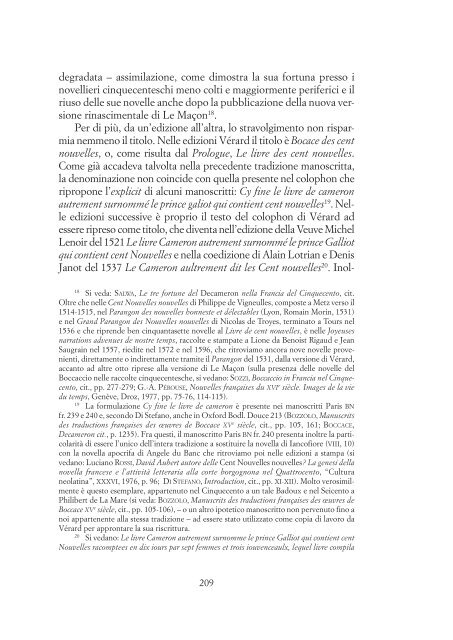
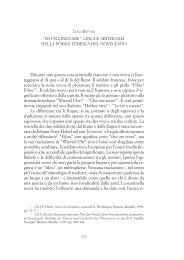

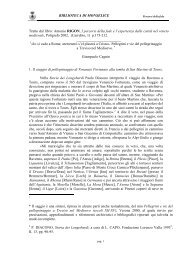
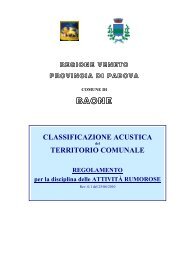
![Intero volume in formato PDF 6 MB circa [vai.] - Provincia di Padova](https://img.yumpu.com/16370153/1/174x260/intero-volume-in-formato-pdf-6-mb-circa-vai-provincia-di-padova.jpg?quality=85)
